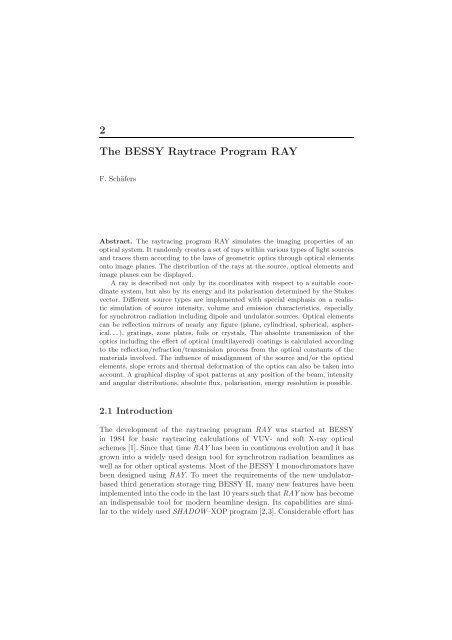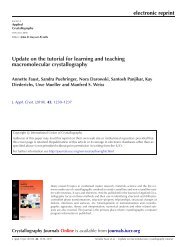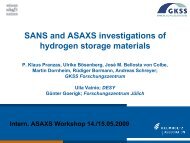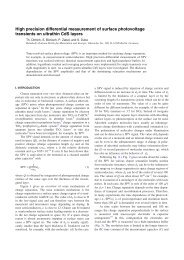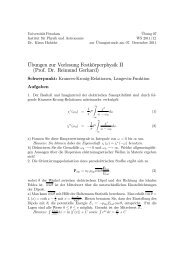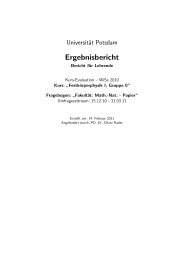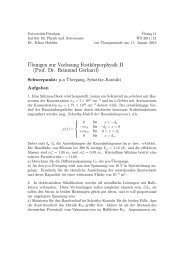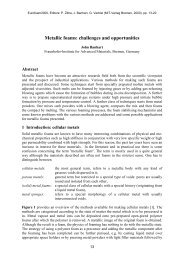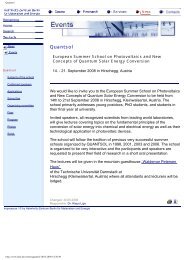2 The BESSY Raytrace Program RAY - Helmholtz-Zentrum Berlin
2 The BESSY Raytrace Program RAY - Helmholtz-Zentrum Berlin
2 The BESSY Raytrace Program RAY - Helmholtz-Zentrum Berlin
Create successful ePaper yourself
Turn your PDF publications into a flip-book with our unique Google optimized e-Paper software.
2<br />
<strong>The</strong> <strong>BESSY</strong> <strong>Raytrace</strong> <strong>Program</strong> <strong>RAY</strong><br />
F. Schäfers<br />
Abstract. <strong>The</strong> raytracing program <strong>RAY</strong> simulates the imaging properties of an<br />
optical system. It randomly creates a set of rays within various types of light sources<br />
and traces them according to the laws of geometric optics through optical elements<br />
onto image planes. <strong>The</strong> distribution of the rays at the source, optical elements and<br />
image planes can be displayed.<br />
A ray is described not only by its coordinates with respect to a suitable coordinate<br />
system, but also by its energy and its polarisation determined by the Stokes<br />
vector. Different source types are implemented with special emphasis on a realistic<br />
simulation of source intensity, volume and emission characteristics, especially<br />
for synchrotron radiation including dipole and undulator sources. Optical elements<br />
can be reflection mirrors of nearly any figure (plane, cylindrical, spherical, aspherical.<br />
. . ), gratings, zone plates, foils or crystals. <strong>The</strong> absolute transmission of the<br />
optics including the effect of optical (multilayered) coatings is calculated according<br />
to the reflection/refraction/transmission process from the optical constants of the<br />
materials involved. <strong>The</strong> influence of misalignment of the source and/or the optical<br />
elements, slope errors and thermal deformation of the optics can also be taken into<br />
account. A graphical display of spot patterns at any position of the beam, intensity<br />
and angular distributions, absolute flux, polarisation, energy resolution is possible.<br />
2.1 Introduction<br />
<strong>The</strong> development of the raytracing program <strong>RAY</strong> was started at <strong>BESSY</strong><br />
in 1984 for basic raytracing calculations of VUV- and soft X-ray optical<br />
schemes [1]. Since that time <strong>RAY</strong> has been in continuous evolution and it has<br />
grown into a widely used design tool for synchrotron radiation beamlines as<br />
well as for other optical systems. Most of the <strong>BESSY</strong> I monochromators have<br />
been designed using <strong>RAY</strong>. To meet the requirements of the new undulatorbased<br />
third generation storage ring <strong>BESSY</strong> II, many new features have been<br />
implemented into the code in the last 10 years such that <strong>RAY</strong> now has become<br />
an indispensable tool for modern beamline design. Its capabilities are similar<br />
to the widely used SHADOW–XOP program [2,3]. Considerable effort has
10 F. Schäfers<br />
been made to ensure that it is a user friendly, easy accessable and easy-to-learn<br />
program for everyday use with a minimum effort on data and file handling.<br />
Alternative to these programs based on intensity distributions and geometric<br />
optics, wavefront propagation codes have been developed such as<br />
PHASE [4], which applies the Stationary Phase Approximation and SRW [5]<br />
employing Fourier Optics, which on the basis of the complex electric field<br />
of the radiation are able to intrinsically take into account interference and<br />
coherence effects. <strong>The</strong>se codes are treated separately in this book [6].<br />
This report is intended to be a practical reference and to give an outline<br />
of the underlying geometrical, mathematical, physical and optical principles<br />
which can be found in textbooks [7–9] or synchrotron radiation handbooks<br />
[10]. In particular, Chap. 3.2 of [10] (Ray tracing) is strongly recommended<br />
as an introductory guide before calculating a real beamline design. Here the<br />
procedure, problems, limitations and the importance of checking the raytrace<br />
results for the various kinds of errors that can occur are discussed. Various<br />
specific <strong>RAY</strong>-features have been described previously: crystal optics in [11]<br />
and zoneplate optics employing Fresnel diffraction where the collective effects<br />
are treated on a statistical (Monte Carlo) basis [12, 13]. Extended manuals<br />
for <strong>RAY</strong> [14] and the reflectivity program REFLEC [15] which share the<br />
same optics software library are also available. Examples for the use of the<br />
program in a variety of synchrotron radiation applications are given in [16]:<br />
plane grating monochromator (PGM-) beamlines, [17] IR-beamlines, [18] elliptical<br />
undulator beamlines, [19] gradient crystal monochromators, [20] μ-focus<br />
X-ray beamline.<br />
Chapter 3 explains the basic statistical treatment to simulate any kind<br />
of intensity patterns, while the next chapters describe the simulation of<br />
sources (Chap. 4), optical elements (Chap. 5) and of the treatment of absolute<br />
reflectivity and polarisation (Chap. 6).<br />
In Chap. 7 crystal diffraction optics employing dynamical theory is<br />
described. Looking ahead, in ‘Outlook’, the time evolution of the rays to<br />
describe wave, coherence and interference phenomena is discussed (Chap. 8).<br />
This extension of the program and the implementation of the zoneplate<br />
optics [12, 13] have been made possible by support through the COST-P7<br />
action and intensive discussions during the COST meetings.<br />
<strong>The</strong> complete code is available as a PC-Windows version.<br />
2.2 Beamline Design and Modelling<br />
<strong>The</strong> raytracing program <strong>RAY</strong> simulates the imaging and focussing properties<br />
of an optical system. It randomly creates a set of rays within various types of<br />
light sources and traces them through one or more optical elements on image<br />
planes. <strong>The</strong> geometric distribution of the rays at the source, at all optical<br />
elements and at the image planes can be visualized.
FEM<br />
ANSYS / ProE<br />
temperature distribution<br />
2<br />
photons/s/mm /BW<br />
x 10<br />
1000<br />
12<br />
800<br />
600<br />
400<br />
200<br />
vert. position (mm)<br />
2 <strong>The</strong> <strong>BESSY</strong> <strong>Raytrace</strong> <strong>Program</strong> <strong>RAY</strong> 11<br />
photon source<br />
WAVE / URGENT / SMUT<br />
JOB 38 UE52<br />
spatial distribution<br />
optical elements<br />
REFLEC<br />
E = 396eV<br />
1<br />
0.75<br />
0.5<br />
0.25<br />
1.5<br />
1<br />
0<br />
0.5<br />
-0.25<br />
0<br />
-0.5<br />
-0.5<br />
-0.75 -1<br />
-1.5<br />
-1<br />
Distribution in pinhole<br />
hori. position (mm)<br />
raytracing<br />
<strong>RAY</strong><br />
blaze angle(°)<br />
1.0<br />
0.8<br />
0.6<br />
0.4<br />
0.2<br />
0.2 0.4 0.6 0.8<br />
cff 0.6<br />
0.4<br />
0.2<br />
0.0<br />
grating efficiency<br />
grating efficiency<br />
gratings<br />
EFFI<br />
y (mm)<br />
Intensity<br />
0.1<br />
0.0<br />
-0.1<br />
4000<br />
2000<br />
-0.05 0.00 0.05 0.10<br />
Width(x): 0.0472 mm<br />
Center : 0.014 mm<br />
0<br />
-0.05 0.00 0.05 0.10<br />
x (mm)<br />
Width(y): 0.0819 mm<br />
Center : -0.002 mm<br />
0.1<br />
0.0<br />
-0.1<br />
0 5000<br />
Intensity<br />
u41-162-0p7-40-ray<br />
1. image at : 755.00 mm<br />
N/s/0.1A/ 0.0mrad/ 0.1000%BW .1360D+16<br />
Transmission: 44.889 %<br />
112222( 112222) out of 250000<br />
N max /mm 2 : 0.6915D+18<br />
S1: 1.000 S2: 0.000 S3: 0.000<br />
spot pattern<br />
Fig. 2.1. <strong>BESSY</strong> soft X-ray computational tools and their interplay<br />
Various interesting features like focal properties, power distribution, energy<br />
resolution, rocking curves, absolute transmission and polarisation characteristics<br />
of an optical setup are simulated. It combines pure geometrical raytracing<br />
with calculations of the absolute transmission and is, thus, a central and<br />
indispensable part of the <strong>BESSY</strong> software tools for the design and optimization<br />
of new monochromators and beamlines from the infrared spectral<br />
region to the hard X-ray range. <strong>The</strong> interplay of the software tools available<br />
at <strong>BESSY</strong> [21, 22], is demonstrated in Fig. 2.1 as a flowchart.<br />
Special emphasis was put on realistic simulations of beamlines, in particular<br />
those employing synchrotron radiation: the path of the photons can be<br />
followed from any source, including bending magnets and insertion devices<br />
via reflection/diffraction/transmission at optical elements through apertures,<br />
entrance and/or exit slits on the sample. <strong>The</strong> influence of slope errors, surface<br />
roughness, thermal bumps, measured or calculated surface profiles as well as<br />
a misalignment of the source and optical elements can be studied in a simple<br />
way. Thus, it is possible to predict the real performance of the beamline under<br />
realistic conditions and to specify the requirements for all the components to<br />
be ordered.<br />
In a well defined source volume, rays are created within a given horizontal<br />
and vertical divergence. Each ray has the same intrinsic probability.<br />
<strong>The</strong> spatial and angular intensity distribution of the source is given by the<br />
spatial and angular density of the rays (i.e. rays per volume and solid angle).<br />
Thus, the outgoing rays simulate the intensity distribution of the corresponding<br />
source. <strong>The</strong> rays are traced according to geometrical optics through one<br />
or more optical elements (mirrors, gratings, foils, crystals, slits, zoneplates)
12 F. Schäfers<br />
of which the surface can have nearly any figure such as plane, cylindrical,<br />
spherical, toroidal, paraboloidal or ellipsoidal and can be arranged in any<br />
geometry (horizontal, vertical, oblique). <strong>The</strong> absolute transmission of the<br />
optics including the effect of (multilayer-) coatings is calculated according<br />
to the reflection/refraction/transmission/diffraction processes from the optical<br />
constants of the involved materials. Special monochromator mounts and<br />
(coma-corrected) varied line-spacing (VLS-) gratings and (graded) crystals<br />
with automatic calculation of structure factors can also be handled.<br />
A ray is determined not only by its coordinates with respect to a suitable<br />
coordinate system (e.g. by its starting point) and by its direction,<br />
but also by its energy E, its polarisation, described by the Stokes vector<br />
S =(S0,S1,S2,S3), and its pathlength. Thus, a ray is described by 12 parameters,<br />
which are traced through the optical setup and for which the geometrical<br />
and optical modifications are calculated according to its interaction with the<br />
optical coating (reflection/refraction/transmission). Since all rays have equal<br />
probability (the intensity of a ray, S0, is either 1 or 0), the throughput of<br />
a beamline is simply given by the number of rays, for SR-sources multiplied<br />
with the absolute photon flux as scaling factor.<br />
For a first overview of the focal properties of an optical system, the horizontal<br />
and vertical widths of the beam can be visualized along the beam path<br />
for the determination of the focus position. At any position along the beam<br />
path image planes can be defined. <strong>The</strong> footprints of the rays on the optical<br />
elements and the focal properties of the optical system are analyzed and are<br />
visualized graphically as point diagrams, 2D or 3D intensity distributions etc.<br />
<strong>The</strong> menu-driven program is user friendly and so a first-performance test<br />
of an optical design can be gained rapidly without any file handling. Once the<br />
beamline has been defined the parameters are stored and can be modified in a<br />
subsequent run. <strong>The</strong> graphics output is directed to monitors, printers, or PS<br />
or EPS-files, and alternatively ASCII-data tables of all results can be created<br />
for further data evaluation and display.<br />
A flowchart of the program is shown in Fig. 2.2.<br />
2.3 Statistics: Basic Laws of <strong>RAY</strong><br />
2.3.1 All Rays have Equal Probability<br />
To simulate realistic intensity patterns on optical elements and image planes<br />
(e.g. for heat load studies) it is necessary to create the source points and the<br />
rays in such a way that the same intensity is attributed to each ray.<br />
Generally there are two possibilities:<br />
• A systematic distribution of the rays within the source so that the real<br />
emission characteristic is simulated. For this a large number of rays is<br />
required and needs to be calculated before an optical setup is completely<br />
described.
2 <strong>The</strong> <strong>BESSY</strong> <strong>Raytrace</strong> <strong>Program</strong> <strong>RAY</strong> 13<br />
Fig. 2.2. Flow chart of <strong>RAY</strong><br />
• <strong>The</strong> rays are distributed statistically within the source so that within the<br />
statistical error the real emission characteristic is simulated. <strong>The</strong> intensity<br />
distribution of the source is thus understood as the probability distribution<br />
of the necessary parameters, namely position and angle. <strong>The</strong> main advantages<br />
of this Monto–Carlo procedure are its simplicity and the fact that a<br />
calculation of relatively few rays already is enough to create a reasonable
14 F. Schäfers<br />
simulation of the optics. When the statistics and the accuracy seem to<br />
be sufficient, the calculation can always be interrupted without making a<br />
systematic error.<br />
This second option is realized in <strong>RAY</strong>. <strong>The</strong> procedure is as follows:<br />
1. Create a random number ran1 between 0 and 1.<br />
2. Scale the corresponding variable, e.g. the x-coordinate of the source point:<br />
x =(ran1 − 0.5) dx, (2.1)<br />
where dx is the source-dimension in the x-direction.<br />
3. Calculate the probability, w, of this randomly chosen start value for x (normalized<br />
to a maximum value of 1), for example the electron density in a<br />
dipole-source (gaussian profile w(x) =exp(−x2 /(2σ2 y)) or the synchrotron<br />
radiation intensity for a fixed wavelength at a definite horizontal and<br />
vertical emission angle (Schwinger theory [23]).<br />
4. Create a second random number ran2. <strong>The</strong> ray is accepted only if the<br />
difference of the probability w(x) and this new random number is larger<br />
than zero:<br />
w (x) − ran2 > 0. (2.2)<br />
5. If the difference is less than zero neglect this ray and start again with a<br />
new one according to (2.1).<br />
2.3.2 All Rays are Independent, but... (Particles and Waves)<br />
All rays are independent, and so they are considered as individual particles<br />
not knowing anything about each other. Thus, <strong>RAY</strong> works exclusively in the<br />
particle model. Nevertheless, the statistical method explained above is an<br />
elegant way to overcome the particle–wave dualism and to simulate wave<br />
phenomena and collective effects such as interference, diffraction, coherence<br />
and wave fronts.<br />
This is done by a statistical treatment of an ensemble of individual rays<br />
which behave within the statistical errors as a collective unit, as a wavefront.<br />
This random selection of a parameter is used extensively throughout the<br />
program not only to simulate the emission characteristics of a light source,<br />
but also, for example, to simulate the reflection angle on a mirror to simulate<br />
slope errors that are assumed to be gaussian. It is used to simulate reflection<br />
lossesofrayswherew(x) =R with (0
2.4 Treatment of Light Sources<br />
2 <strong>The</strong> <strong>BESSY</strong> <strong>Raytrace</strong> <strong>Program</strong> <strong>RAY</strong> 15<br />
Various light sources are incorporated in <strong>RAY</strong>. Generally the rays are starting<br />
in a defined source volume and are emitted with a defined horizontal and<br />
vertical divergence. Either hard (flat-top) edges or a gaussian distribution<br />
profile can be simulated. In the latter case, rays are created statistically (see<br />
3.1) within a ±3σ-width of the gaussian profile (i.e. more than 99.9% of the<br />
intensity).<br />
For synchrotron radiation beamlines, the polarised emission characteristic<br />
of bending magnets, wigglers and undulators is incorporated. For other<br />
sources, such as twin or helical undulators, or to take beam emittance effects<br />
into account, the input can be given as an ASCII-file taken from programs<br />
for undulator radiation: URGENT [24], SMUT [25] or WAVE [26]. In this file<br />
the intensity and polarisation patterns of the light source must be described<br />
as intensity (photons/seconds) and Stokes parameters at a distance of 10 m<br />
from the centre of the source in a suitable x-y mesh.<br />
Each ray is attributed an energy, E, and a polarisation. <strong>The</strong> energy can be<br />
varied continuously within a ‘white’ hard-edge band of E0 ± ΔE, or toggled<br />
between three discrete energies E0, E0+ΔE and E0−ΔE. This feature allows<br />
one to determine easily the energy dispersion and the spatial separation of<br />
discrete energies for monochromator systems, thereby giving a picture of the<br />
energy resolution that one can expect.<br />
Table 2.1 lists the main features of the different light sources.<br />
<strong>The</strong> source coordinate system for the case of bending magnet synchrotron<br />
radiation is given in Fig. 2.3. <strong>The</strong> storage ring is located in the x-z plane,<br />
Table 2.1. Parameters of the <strong>RAY</strong>-sources<br />
Name Width Height Length Div. Div. S0 S1,S2,S3<br />
x y z hor. φ vert. ψ<br />
Matrix MA Hard Hard Hard Hard Hard 1 Input<br />
Point PO Hard Hard Hard Hard Hard 1 Input<br />
soft soft soft soft<br />
Circle CI Hard Hard Hard Hard Hard 1 Input<br />
Dipole DI Soft Soft Hard Hard Calc. Flux Calc.<br />
Wiggler WI Soft Soft L = nλu Hard Calc. Flux Calc.<br />
Wiggler/Undul. WU Soft Soft 0 Calc. Calc. Flux Input<br />
Double–Undul. HU Soft Soft Hard Soft Soft Flux Input<br />
Undul.–data file UF Soft Soft Hard File File Flux File<br />
Helical Undul.<br />
data file<br />
HF Soft Soft Hard File File Flux File<br />
Source data file FI Soft Soft Hard File File 1 Input<br />
hrd, a hard (flat-top) edge; soft, soft – a gaussian distribution of the respective<br />
variable within a 6σ-width is simulated; calc, calculated according to a theoretical<br />
model (e.g. Schwinger theory); n, number of wiggler periods; L, length of undulator;<br />
λu, period length; file, parameters taken from data-file; input, parameters to be given<br />
interactively
16 F. Schäfers<br />
X so<br />
counter-clockwise rev.<br />
(e.g. <strong>BESSY</strong> I)<br />
Y so<br />
clockwise rev.<br />
(e.g. <strong>BESSY</strong> II)<br />
Fig. 2.3. Coordinate system for storage ring-bending magnet sources (DI pole) as<br />
viewed from above<br />
PO_int<br />
Z so<br />
PI_xel CI_rcle<br />
Fig. 2.4. Spot pattern of various source types in x-y plane, projected onto z =0<br />
DI_pole,<br />
Clockwise<br />
revolution<br />
DI_pole,<br />
Counter-Clockwise<br />
revolution<br />
WI_ggler, seen<br />
from top<br />
(x-z plane)<br />
Fig. 2.5. Spot pattern of synchrotron radiation sources in x-y plane, projected onto<br />
z =0<br />
for clockwise revolution of the electrons the x-axis is pointing away from the<br />
centre, while for counter-clockwise revolution the x-axis is pointing inside<br />
the storage ring centre. This is important to be noticed especially for optical<br />
systems with large horizontal divergence (e.g. IR-beamlines), where the<br />
source cross section is very asymmetric because of the depth-of-field effect<br />
(see Fig. 2.5).<br />
Examples of the intensity distribution (footprints) of various sources are<br />
given in the Figs. 2.4 and 2.5.
2 <strong>The</strong> <strong>BESSY</strong> <strong>Raytrace</strong> <strong>Program</strong> <strong>RAY</strong> 17<br />
2.5 Interaction of Rays with Optical Elements<br />
2.5.1 Coordinate Systems<br />
<strong>The</strong> definition of the coordinate system used in <strong>RAY</strong> is shown in Figs. 2.6<br />
and 2.7. Its origin lies in the centre of the source (with the x-axis in general<br />
(e.g. SR) being horizontal). <strong>The</strong> coordinate system is transformed along the<br />
optical path from the source to the optical elements and then to the image<br />
planes. <strong>The</strong> z-axis points into the direction of the central ray, the x-axis<br />
is perpendicular to the plane of reflection, i.e. horizontal in the case of a<br />
vertically deviating optical setup (azimuthal angles 0 ◦ or 180 ◦ ), and it is<br />
vertical for horizontal mounts (azimuthal angles 90 ◦ (to the right) and 270 ◦<br />
(to the left), respectively). <strong>The</strong> y-axis is always the normal in the centre of the<br />
optical element. <strong>The</strong> plane of reflection or dispersion is, thus, always the y-z<br />
plane and the surface of the optical elements is the x-z-plane, regardless of<br />
the azimuthal angle χ chosen. After the optical element the coordinate system<br />
X so<br />
ψ<br />
X so<br />
ψ<br />
φ<br />
Y so<br />
SOURCE<br />
φ<br />
COORDINATE SYSTEM OF <strong>RAY</strong><br />
Vertical mount<br />
Y so<br />
χ<br />
χ<br />
Z so<br />
Z so<br />
α β<br />
YMi 2Θ<br />
XMi 1. OPTICAL<br />
ELEMENT<br />
X Mi<br />
α<br />
2Θ<br />
β<br />
Y Mi<br />
x Im<br />
Z Mi<br />
Horizontal mount<br />
y Im<br />
Z Mi<br />
z Im<br />
IMAGE<br />
PLANE<br />
Fig. 2.6. Coordinate system (right-handed screw) and angles used in <strong>RAY</strong>. (Top)<br />
Vertical deviation (upwards (downwards)) mount (azimuthal angle χ =0 ◦ (180 ◦ )).<br />
(Bottom) Horizontal deviation (to the right (left)) (azimuthal angle χ =90 ◦ (270 ◦ )).<br />
<strong>The</strong> optical element is always in the XM-ZM-plane<br />
Y Im<br />
χ<br />
X Im<br />
Z Im
18 F. Schäfers<br />
x<br />
y<br />
z<br />
Fig. 2.7. Coordinate systems used in <strong>RAY</strong>. For optical elements (left) the coordinate<br />
system is fixed to the optical surface (X-Z plane). Transmission elements, screens<br />
and image planes (right) areintheX-Y plane, the x-axis is in the horizontal plane.<br />
<strong>The</strong> red line is the light beam<br />
for the outgoing ray is rotated back by −χ, i.e. it has the same orientation as<br />
before the optical element. In this way another optical element can be treated<br />
in an identical manner.<br />
2.5.2 Geometrical Treatment of Rays<br />
<strong>The</strong> geometric calculations proceed in the following way:<br />
Statistical creation of a ray within a given source volume and emission cone<br />
and within the ‘correct’ statistics (see Chap. 3). <strong>The</strong> ray is determined by its<br />
source coordinates (xs,ys,zs) and its direction cosines (ls,ms,ns) determined<br />
by the horizontal and vertical emission angles ϕ and ψ (see Fig. 2.8):<br />
⎛<br />
�αS = ⎝ lS<br />
⎞ ⎛ ⎞<br />
sin ϕ cos ψ<br />
mS ⎠ = ⎝ sin ψ ⎠ (2.3)<br />
cos ϕ cos ψ<br />
nS<br />
<strong>The</strong> vector equation of the ray is then<br />
or, in coordinates<br />
or<br />
�x = �xS + t�αS with tεℜ + 0 (2.4)<br />
⎛<br />
⎝ x<br />
⎞ ⎛<br />
y ⎠ =<br />
z<br />
x − xs<br />
lS<br />
⎝ xs<br />
ys<br />
= y − ys<br />
zs<br />
⎞ ⎛<br />
⎠ + t<br />
mS<br />
= z − zs<br />
⎝ lS<br />
mS<br />
nS<br />
nS<br />
x<br />
y<br />
⎞<br />
⎠ (2.5)<br />
z<br />
(2.6)
Y<br />
X<br />
2 <strong>The</strong> <strong>BESSY</strong> <strong>Raytrace</strong> <strong>Program</strong> <strong>RAY</strong> 19<br />
x<br />
ψ<br />
ϕ<br />
n=cosϕcosψ<br />
m=sinψ<br />
l=sinϕcosψ<br />
Fig. 2.8. Source coordinate system: Definition of angles and direction cosines<br />
in <strong>RAY</strong><br />
2.5.3 Intersection with Optical Elements<br />
<strong>The</strong> source coordinate is translated into a new coordinate system with the<br />
origin in the centre of the first optical element (hit by the central ray), and<br />
the z-axis parallel to a symmetry axis of the optical element (for a simplified<br />
equation). <strong>The</strong> coordinate system is translated by the ‘distance from the<br />
source’ totheopticalelement,zq, rotated around z by the azimuthal angle,<br />
χ, and around the new ˜x-axis by the grazing incidence angle, θ. <strong>The</strong>transformation<br />
to the new-coordinate system is performed by the following matrix<br />
operations:<br />
�xS ′ = D˜x (θ) Dz (χ) Tz (zq) �xS (2.7)<br />
zq distance source to first optical element or nth to (n + 1)th element<br />
θ rotation angle around x (y-z plane)<br />
χ azimuthal rotation around z (x-y plane) (clockwise),<br />
which corresponds to<br />
⎛<br />
xS ′<br />
⎝ yS ′<br />
zS ′<br />
⎞ ⎛<br />
⎞ ⎛<br />
⎞ ⎛⎛<br />
1 0 0 cos χ −sinχ 0<br />
⎠ = ⎝0cosθ−sinθ⎠ ◦ ⎝sin χ cos χ 0⎠<br />
◦ ⎝⎝<br />
0sinθcos θ 0 0 1<br />
xS<br />
⎞ ⎛<br />
yS ⎠ − ⎝<br />
zS<br />
0<br />
0<br />
⎞⎞<br />
⎠⎠<br />
zq<br />
⎛<br />
xS ′<br />
or finally ⎝ yS<br />
(2.8)<br />
′<br />
zS ′<br />
⎞ ⎛<br />
⎠ = ⎝ xs<br />
⎞<br />
cos χ − ys sin χ<br />
xs sin χ cos θ + ys cos χ cos θ − (zs − zq)sinθ⎠<br />
(2.9)<br />
xs sin χ sin θ + ys cos χ sin θ +(zs − zq)cosθ<br />
Z
20 F. Schäfers<br />
<strong>The</strong> direction cosines are transformed correspondingly:<br />
and finally<br />
⎛<br />
⎝<br />
lS ′<br />
mS ′<br />
nS ′<br />
�αS ′ = D˜x (θ) Dz (χ) �αS, (2.10)<br />
⎞ ⎛<br />
⎠ = ⎝ ls<br />
⎞<br />
cos χ − ms sin χ<br />
ls sin χ cos θ + ms cos χ cos θ ⎠ . (2.11)<br />
ls sin χ sin θ + ms cos χ sin θ<br />
In the new coordinate system the ray is described by<br />
⎛<br />
⎝ x<br />
⎞ ⎛<br />
xS ′<br />
y ⎠ (t) = ⎝ yS<br />
z<br />
′<br />
zS ′<br />
⎞ ⎛<br />
lS ′<br />
⎠ + t ⎝ mS ′<br />
nS ′<br />
⎞<br />
⎠ (2.12)<br />
2.5.4 Misalignment<br />
A six-dimensional misalignment of an optical element can be taken into<br />
account: three translations of the coordinate system by δx, δy and δz and<br />
three rotations by the misorientation angles δχ (x-y plane), δϕ (x-z plane)<br />
and δψ (y-z plane). Since the rotations are not commutative, the coordinate<br />
system is first rotated by these angles in the given order and then translated.<br />
For the outgoing ray to be described in the non-misaligned system, the coordinate<br />
system is backtransformed (in reverse order). Thus, the optical axis<br />
remains unaffected by the misalignment.<br />
2.5.5 Second-Order Surfaces<br />
Optical elements are described by the general equation for second-order<br />
surfaces:<br />
F (x, y, z) =a11x 2 + a22y 2 + a33z 2 +2a12xy +2a13xz<br />
+2a23yz +2a14x +2a24y +2a34z + a44 =0.<br />
(2.13)<br />
This description refers to a right-handed coordinate system attached to the<br />
centre of the mirror with its surface in x-z plane, and y-axis points to the<br />
normal). This coordinate system is used for the optical elements PL ane,<br />
CO ne, CY linder and SP here.<br />
Note that for the elements EL lipsoid and PA raboloid acoordinatesystem<br />
is used, which again is attached to the centre of the mirror (with x-axis on the<br />
surface), but the z-axis is parallel to the symmetry axis of this element for an<br />
easier description in terms of the aij parameters (see Figs. 2.9 and 2.10). <strong>The</strong><br />
aij-values of Table 2.2 are given for this system. Thus, the rotation angle of<br />
the coordinate system from source to element is here θ +α (EL)and2θ (PA),<br />
respectively, θ being the grazing incidence angle and α the tangent angle on<br />
the ellipse.
Source<br />
Y So<br />
Z Y<br />
So Ell<br />
YMi Θ<br />
X So<br />
α<br />
Z o<br />
α<br />
2 <strong>The</strong> <strong>BESSY</strong> <strong>Raytrace</strong> <strong>Program</strong> <strong>RAY</strong> 21<br />
Z Ell<br />
Z Mi<br />
Y Ell<br />
b<br />
Y o<br />
X Ell<br />
a<br />
Y Im<br />
Focus<br />
Fig. 2.9. Ellipsoid: definitions and coordinate systems<br />
Y Pa<br />
Directrix<br />
P<br />
Z o<br />
X Pa<br />
Y So<br />
θ<br />
X So<br />
Z Y<br />
So<br />
Pa<br />
YMi θ<br />
θ<br />
Z Pa<br />
Source<br />
Z Mi<br />
Fig. 2.10. Paraboloid: Definitions and coordinate systems<br />
Y Im<br />
X Im<br />
Z Im<br />
X Im<br />
Z Im<br />
<strong>The</strong> individual surfaces are described by the following equations:<br />
• Plane y =0<br />
• Cylinder(in z − dir.) x 2 + y 2 =0<br />
• Cylinder(in x − dir.) y 2 + z 2 =0<br />
• Sphere x 2 +(y − R) 2 + z 2 − R 2 =0<br />
• Ellipsoid x 2 /C 2 +(y − y0) 2 /B 2 +(z − z0) 2 /A 2 − 1=0<br />
• Paraboloid x 2 /C 2 +(y − y0) 2 /B 2 − 2P (z − z0) =0<br />
Z Pa<br />
Z Ell<br />
(2.14)<br />
Alternatively to the input of suitable parameters, such as mirror radii or<br />
half axes of ellipses, in an experts modus (EO), the aij parameters can be<br />
directly given, such that any second-order surface, whatever shape it has, can<br />
be simulated.
22 F. Schäfers<br />
Table 2.2. Parameters of the second-order optical elements<br />
Name PM CY CO SP EL PA<br />
a11 0 1/0 1 − cm 1 B 2 /C 2<br />
P 2 /C 2<br />
a22 0 1 1 − 2cm 1 1 1<br />
a33 0 0/1 0 1 B 2 /A 2<br />
0<br />
a12 0 0 0 0 0 0<br />
a13 0 0 0 0 0 0<br />
�<br />
a23 0 0<br />
cm − c2 m 0 0 0<br />
a14 0 0 0 0 0<br />
a24 −1 ρ · sign −a23 R<br />
√ − R · sign −y0 −y0<br />
cm<br />
zm<br />
2<br />
a34 0 0 0 z0B 2 /A 2<br />
−P<br />
a44 0 0 0 0 y 2 0 + z2 0B2 /A 2 − B 2<br />
y 2 2<br />
0 − 2Pz0 − P<br />
Sign<br />
0 1/−1 1/−1 1/−1 1 1<br />
(concave/convex)<br />
Fx − (a11x + a12y + 0 −x/0 −x −a11x −a11x<br />
a13z + a14)<br />
Fy − (a22y · sign + 1 ρ · sign R · sign y0 − y y0−y a12x a23z + a24)<br />
Fz − (a33z + a13x + 0 0/−z −z −(z0 + z)(B/A)<br />
a23y + a34)<br />
2<br />
P<br />
z0 = A 2 /B 2 y0 tan(α) z0 = f cos(α, β) · sig<br />
y0 = ra sin(θ − α) y0 = f sin(2 α, β)<br />
tan(α) =tan(θ) P =2fsin 2 (θ)sig<br />
(ra − rb)/(ra + rb)<br />
ρ: radiusR, ρ: radii R: radius f: mirror–source/focus–dist.<br />
zm: mirror<br />
A, B, C half axes in z,y,x-dir; C: halfpar. in x; Sig=±1; f.<br />
length cm � �<br />
=<br />
ra, rb: mirror to focus 1,2; θ: collimation/focussing; θ: grazing<br />
2<br />
(r−ρ)<br />
grazing angle of central ray; α: angle of central ray; α, β =2θ, 0<br />
zm<br />
tangent angle<br />
(coll); α, β =0, 2θ (foc.)<br />
Plane Ell.: C = infty.; Rotational Plane P : C = infty.; Rotational<br />
Ell.: B = CA; Ellipsoid: P : C = P ; Elliptical P : C �= P<br />
A �= B �= C; Sphere: A = B = C
2.5.6 Higher-Order Surfaces<br />
2 <strong>The</strong> <strong>BESSY</strong> <strong>Raytrace</strong> <strong>Program</strong> <strong>RAY</strong> 23<br />
A similar expert modus is available for surfaces, which cannot be described<br />
by the second-order equation. <strong>The</strong> general equation is the following:<br />
F (x, y, z) =a11x 2 +signa22y 2 + a33z 2 +2a12xy +2a13xz +2a23yz<br />
+2a14x +2a24y +2a34z + a44 + b12x 2 y + b21xy 2<br />
+ b13x 2 z + b31xz 2 + b23y 2 z + b32yz 2 =0<br />
(2.15)<br />
Here, again all aij and bij parameters can be given explicitly by the user to<br />
describe any geometrical surface.<br />
For special higher order surfaces the surface is described by the following<br />
equations.<br />
Toroid<br />
F (x, y, z) =<br />
�<br />
(R − ρ)+sign(ρ) � ρ2 − x2 �2 − (y − R) 2 − z 2 = 0 (2.16)<br />
Sign = ±1 for concave/convex curvature.<br />
<strong>The</strong> surface normal is calculated according to (see Chap. 5.7)<br />
Fx =<br />
Elliptical Paraboloid<br />
Elliptical Toroid<br />
−2x sign(ρ)<br />
� ρ 2 − x 2<br />
�<br />
(R − ρ)+sign(ρ) � ρ2 − x2 �2 (2.17)<br />
Fy = −2(y − R) (2.18)<br />
Fz = −2z. (2.19)<br />
2fx<br />
F (x, y, z) =<br />
2<br />
2f − z+z0 − 2p(z + z0) − p<br />
cos 2θ<br />
2 =0. (2.20)<br />
In analogy to a spherical toroid, an elliptical toroid is constructed from an<br />
ellipse (instead of a circle) in the (y, z) plane with small circles of fixed radius<br />
ρ attached in each point perpendicular to the guiding ellipse.<br />
<strong>The</strong> mathematical description of the surface is based on the description of<br />
a toroid, where in each point of the ellipse a ‘local’ toroid with radius R(z)<br />
and center (yc(z), zc(z)) is approximated (Fig. 2.11).<br />
Following this description the elliptical toroid surface is given by<br />
F (x, y, z) =0=(z − zc (z)) 2 +(y − yc (z)) 2 �<br />
− R (z) − ρ + � ρ2 − x2 �2 (2.21)
24 F. Schäfers<br />
a<br />
y<br />
α<br />
b<br />
α<br />
R(z 0 ,y 0 )<br />
x<br />
(z 0 ,y 0 )<br />
α<br />
(z c ,y c )<br />
Fig. 2.11. Construction of an elliptical toroid. <strong>The</strong> ET is locally approximated by<br />
a conventional spherical toroid with radius R(z) andcenter(zc(z), yc(z))<br />
with R(z) =a 2 b 2<br />
�<br />
z2 +<br />
a4 � a 2 − z 2 �<br />
a 2 b 2<br />
� 3<br />
2<br />
zc(z) =z − R(z)sinα(z),<br />
yc(z) =y(z)+R(z)cosα(z),<br />
z ′ c =1− R′ sin α − Rα ′ cos α,<br />
y ′ c = y ′ + R ′ cos α − Rα ′ sin α,<br />
y ′′ = ∂2y =<br />
∂z2 = 1<br />
� 2 2 b − a<br />
ab a2 z 2 + a 2<br />
� 3<br />
2<br />
y(z) =− b �<br />
a2 − z2 ,<br />
a<br />
α =arctan(y ′ � �<br />
b z<br />
) = arctan √ ,<br />
a a2 − z2 y ′ = ∂y<br />
b z<br />
=tanα = √<br />
∂z a a2 − z2 α ′ = ∂α y′′<br />
=<br />
∂z 1+y ′2 ,<br />
ab<br />
.<br />
(a 2 − z 2 ) 3<br />
2<br />
<strong>The</strong> surface normal is given by the partial derivatives<br />
∂F<br />
∂x =2<br />
x<br />
�<br />
� R − ρ +<br />
ρ2 − x2 � ρ2 − x2 �<br />
, (2.22)<br />
z
2 <strong>The</strong> <strong>BESSY</strong> <strong>Raytrace</strong> <strong>Program</strong> <strong>RAY</strong> 25<br />
∂F<br />
∂y =2(y−yc), (2.23)<br />
∂F<br />
∂z =2(z−zc(1 − z ′ c) − 2y ′ c(y − yc) − 2R ′�<br />
R − ρ + � ρ2 − x2 �<br />
. (2.24)<br />
2.5.7 Intersection Point<br />
<strong>The</strong> intersection point (xM,yM,zM) of the ray with the optical element is<br />
determined by solving the quadratic equation in t generated by inserting (2.12)<br />
into (2.13) or (2.15). For the special higher-order surfaces (TO, EP, ET) the<br />
intersection point is determined iteratively.<br />
<strong>The</strong>n the local surface normal for this intersection point �n = n(xM,yM,zM)<br />
is found by calculating the partial derivative of F (xM,yM,zM)<br />
with the components<br />
fx = ∂F<br />
∂x<br />
�f = ∇F, (2.25)<br />
fy = − ∂F<br />
∂y<br />
fz = ∂F<br />
. (2.26)<br />
∂z<br />
<strong>The</strong> local surface normal is then given by the unit vector<br />
⎛<br />
�n = ⎝ nx<br />
⎞<br />
⎠ = �<br />
1<br />
⎛<br />
⎝ fx<br />
⎞<br />
⎠ . (2.27)<br />
ny<br />
nz<br />
fx 2 + fy 2 + fz 2<br />
Whenever the intersection point found is outside the given dimensions of the<br />
optical element, the ray is thrown away as a geometrical loss and the next ray<br />
starts within the source according to Chap. 5.2.<br />
2.5.8 Slope Errors, Surface Profiles<br />
Once the intersection point and the local surface normal is found, these are<br />
the parameters that are modified to include real surfaces as deviations from<br />
the mathematical surface profile, namely figure and finish errors (slope errors,<br />
surface roughness), thermal distortion effects or measured surface profiles.<br />
<strong>The</strong> surface normal is modified incrementally by rotating the normal<br />
vector in the y-z (meridional plane) and in the x-y plane (sagittal). <strong>The</strong><br />
determination of the rotation angles depends on the type of error to be<br />
included.<br />
1. Slope errors, surface roughness: the rotation angles are chosen statistically<br />
(according to the procedure described in Sect. 2.3.1) within a 6σ-width of<br />
the input value for the slope error.<br />
2. <strong>The</strong>rmal bumps: a gaussian height profile in x- andz-direction with a given<br />
amplitude, and σ-width can be put onto the mirror centre.<br />
fy<br />
fz
26 F. Schäfers<br />
3. Cylindrical bending: a cylindrical profile in z-direction (dispersion direction)<br />
with a given amplitude can be superimposed onto the mirror surface.<br />
4. Measured surface profiles, e.g. by a profilometer.<br />
5. Surface profiles calculated separately, e.g. by a finite element analysis<br />
program.<br />
In cases (2–5) the modified mirror is stored in a 251 × 251 surface mesh<br />
which contains the amplitudes (y-coordinates). For cases (2) and (3) this mesh<br />
is calculated within <strong>RAY</strong>, for the cases (4) and (5) ASCII data files with<br />
surface profilometer data (e.g. LTP or ZEISS M400 [27]) or finite-elementanalysis<br />
data (e.g. ANSYS [28]) can be read in. <strong>The</strong> new y-coordinate of<br />
the intersection point and the local slope are interpolated from such a table<br />
accordingly.<br />
2.5.9 Rays Leaving the Optical Element<br />
For those rays that have survived the interaction with the optical element –<br />
geometrically and within the reflectivity statistics (Chap. 6) – the direction<br />
cosines of the reflected/transmitted/refracted ray (�α2) =(l2,m2,n2) arecalculated<br />
from the incident ray (�α1) =(l1,m1,n1) and the local surface normal<br />
�n.<br />
Mirrors<br />
For mirrors and crystals the entrance angle, α, is equal to the exit angle, β.<br />
In vector notation this means that the cross product is<br />
n × (�α2 − �α1) =0, (2.28)<br />
since the difference vector is parallel to the normal. For the direction cosines<br />
of the reflected ray the result is given by<br />
α2 = �α1 − 2(�n ◦ �α1)�n (2.29)<br />
or in coordinates<br />
lnx +mny + nnz<br />
l2 = l1 − 2nx<br />
nx 2 + ny 2 + nz 2<br />
and, correspondingly, for m2 and n2.<br />
Gratings<br />
(2.30)<br />
<strong>The</strong> emission angle β for diffraction gratings is obtained by the grating<br />
equation<br />
kλ = d (sin α +sinβ) , (2.31)<br />
k, diffraction order; λ, wavelength; d, grating constant.
2 <strong>The</strong> <strong>BESSY</strong> <strong>Raytrace</strong> <strong>Program</strong> <strong>RAY</strong> 27<br />
1. <strong>The</strong> grating is rotated by δχ = a tan(nx/ny) around the z-axis and by<br />
δψ = a sin(nz) around the x-axis, so that the intersection point is plane<br />
(surface normal parallel to the y-axis). <strong>The</strong> grating lines are parallel to the<br />
x-direction.<br />
2. <strong>The</strong>n the direction cosines of the diffracted beam are determined by<br />
⎛<br />
⎝ l2<br />
⎞ ⎛<br />
l1 �<br />
m2 ⎠ ⎜<br />
= ⎝ m2 1 + n21 − (n1 − a1) 2<br />
⎞<br />
⎟<br />
⎠ , (2.32)<br />
n2<br />
n1 − a1<br />
a1 = k λ<br />
cos δψ.<br />
d<br />
3. <strong>The</strong> grating is rotated back to the original position by −δψ and −δχ.<br />
For varied line spacing (VLS) gratings, the local line density n =1/d(l/mm)<br />
as a function of the (x, z)-position is determined by [29]<br />
n = n0 · � 1+2b2z +3b3z 2 +4b4z 3 +2b5x +3b6x 2 +4b7x 3� . (2.33)<br />
Transmitting Optics<br />
For transmitting optics (SL it, FO il) the direction of the ray is unchanged by<br />
geometry. However, diffraction is taken into account for the case of rectangular<br />
or circular slits by randomly modifying the direction of each ray according to<br />
the probability for a certain direction ϕ<br />
sin u<br />
P (ϕ) = , (2.34)<br />
u<br />
πb sin ϕ<br />
with u = (b, slit opening; λ, wavelength),<br />
λ<br />
so that for a statistical ensemble of rays a Fraunhofer (rectangular slits) or<br />
bessel pattern (circular slits) appears (see Fig. 2.12). ZO neplate transmitting<br />
optics are described in [12, 13].<br />
Azimuthal Rotation<br />
After successful interaction with the optical element the surviving ray is<br />
described in a coordinate system, which is rotated by the reflection angle<br />
θ and the azimuthal angle χ, such that the z-axis follows once again the<br />
direction of the outgoing central ray as it was for the incident ray. <strong>The</strong> old<br />
values of the source/mirror points and direction cosines are replaced by these<br />
new ones, so that a new optical element can be attached now in similar way.
28 F. Schäfers<br />
Fig. 2.12. Fraunhofer diffraction pattern on a rectangular slit<br />
2.5.10 Image Planes<br />
If the ray has traversed the entire optical system, the intersection points<br />
(xI, yI) with up to three image planes at the distances zI1,2,3 are determined<br />
according to � � � �<br />
xI x<br />
= +<br />
yI y<br />
1<br />
� �<br />
l<br />
(zI1,2,3 − z). (2.35)<br />
n m<br />
Once a ray reaches the image plane or whenever a ray is lost within the optical<br />
system a new ray is created within the source and the procedure starts all over.<br />
2.5.11 Determination of Focus Position<br />
For the case of imaging systems, if the focus position is to be determined, the<br />
x- andy-coordinates of that ray which has the largest coordinates are stored<br />
along the light beam in the range of the expected focal position (search in a<br />
distance from last OE of ...+/− ...). <strong>The</strong> so found cross section of the beam<br />
(width and height) is displayed graphically. Since at each position a different<br />
ray may be the outermost one, there may be bumps in this focal curve which<br />
depend on the quality of the imaging. Especially, for optical systems with large<br />
divergences (and thus large optical aberrations) or which include dispersing<br />
elements, this curve is only schematic and serves as a quick check of the focal<br />
properties of the system.<br />
2.5.12 Data Evaluation, Storage and Display<br />
<strong>The</strong> x, z-coordinates of the intersection point (x, y for source, slits, foils,<br />
zoneplates and image planes) and the angles l, n (l, m, respectively) are stored<br />
into 100 × 100 matrices. <strong>The</strong>se matrices are multichannel arrays, one for the<br />
source, for each optical element and for each image plane, whose dimensions
2 <strong>The</strong> <strong>BESSY</strong> <strong>Raytrace</strong> <strong>Program</strong> <strong>RAY</strong> 29<br />
(and with it the pixel size) have been fixed before in a ‘test-raytrace’ run.<br />
<strong>The</strong>y represent the illuminated surface in x-z projection. <strong>The</strong> corresponding<br />
surface pixel element that has been hit by a ray is increased by 1, so that<br />
intensity profiles and/or heat load can be displayed.<br />
Additionally, the x- andz-coordinates (y, respectively) of the first 10,000<br />
rays are stored in a 10,000x2 ASCII matrix to display footprint patterns of<br />
the optical elements, for point diagrams at the image planes or for further<br />
evaluation outside the program.<br />
2.6 Reflectivity and Polarisation<br />
Not only the geometrical path of the rays is followed, but also the intensity<br />
and polarisation properties of each ray are traced throughout an optical<br />
setup. Thus, it is easily possible to preview depolarisation effects throughout<br />
the optical path, or to optimize an optical setup for use as, for example, a<br />
polarisation monitor. For this, each ray is treated individually with a defined<br />
energy and polarisation state.<br />
<strong>RAY</strong> employs the Stokes formalism for this purpose. <strong>The</strong> Stokes vector<br />
�S =(S0, S1, S2, S3) describing the polarisation (S1,S2: linear, S3: circular<br />
polarisation) for each ray is given either as free input parameter or, for dipole<br />
sources, is calculated according to the Schwinger theory. S0, the start intensity<br />
of the ray from the source � S0 = √ S1 2 + S2 2 + S3 2� , is set to 1 for the artificial<br />
sources. It is scaled to a realistic photon flux value for the synchrotron sources<br />
Dipole, Wiggler or the Undulator-File.<br />
<strong>The</strong> Stokes vector is defined by the following equations:<br />
�<br />
S0 = (E o p) 2 +(E o s) 2��<br />
2=1,<br />
�<br />
S1 = (E o p) 2 − (E o s) 2��<br />
2=Pl cos(2δ),<br />
S2 = E o pE o s cos(φp − φs) =Pl sin(2δ),<br />
S3 = −E o pE o s sin(φp − φs) =Pc, (2.36)<br />
with the two components of the electric field vector defined as<br />
Ep,s(z,t) =E o p,s exp [i (ωt − kz + φp,s)] . (2.37)<br />
and Pl, Pc are the degree of linear and circular polarisation, respectively. δ is<br />
the azimuthal angle of the major axis of the polarisation ellipse. Note that<br />
and<br />
Pl = P cos(2ε)<br />
Pc = P sin(2ε), (2.38)<br />
with P being the degree of total polarisation and ε the ellipticity of the<br />
polarisation ellipse (tan ε = Rp/Rs) .
30 F. Schäfers<br />
Phase φp−s<br />
Table 2.3. Definition of circular polarisation<br />
90 ◦ , −270 ◦<br />
−90 ◦ , 270 ◦<br />
(π/2, −3π/2) (−π/2, 3π/2)<br />
Rotation sense (in time) Clockwise Counter-clockwise<br />
Rotation sense (in space) Counter-clockwise Clockwise<br />
Polarisation (optical def.) R(ight) CP L(eft) CP<br />
Helicity (atomic def.) Negative (σ−) Positive (σ+)<br />
Stokes vector Negative Positive<br />
Table 2.4. Physical interaction for the different optical components<br />
Mirrors Gratings Foils Slits Zone-plates Crystals<br />
Fresnel Diffraction Fresnel – – Dynamic<br />
equations<br />
equations<br />
theory<br />
Reflectivity Efficiency Transmission Transmission Transmission Reflectivity<br />
Rs,Rp,Δsp Es,Ep,Δsp Ts,Tp,Δsp Ts,Tp =1 Ts,Tp =1, Rs,Rp,Δsp<br />
Δsp =0 Δsp =0<br />
Since the SR is linearly polarised within the electron orbital plane (Iperp =<br />
0), the plane of linear polarisation is coupled to the x-axis (i.e. horizontal).<br />
Thus, the Stokes vector for SR is defined in our geometry as (see Chap. 3.4)<br />
Plin = S1 =(Iperp − Ipar)/(Iperp + Ipar) =(Iy − Ix)/(Iy + Ix) =−1, (2.39)<br />
S1 = +1 would correspond to a vertical polarisation plane.<br />
For the definition of the circular polarisation the nomenclature of<br />
Westerfeld et al. [30] and Klein/Furtak [31] has been used. This is summarised<br />
in Table 2.3:<br />
For example, for the case of synchrotrons and storage rings, the radiation<br />
that is emitted off-plane, upwards, has negative helicity, right-handed CP<br />
(S3 = −1), when the electrons are travelling clockwise, as seen from the top.<br />
<strong>The</strong> modification of the Stokes vector throughout the beamline by interaction<br />
of the light with the optical surface is described by the following steps<br />
(see e.g. [28]):<br />
(1) Give each ray a start value for the Stokes parameter within the source,<br />
Sini, according to input or as calculated for SR sources<br />
(2) Calculate the intensity loss at the first optical element for s- and ppolarisation<br />
geometry and the relative phase, Δ = δs − δp, according<br />
to the physical process involved (see Table 2.4):<br />
• Mirrors, Foils<br />
<strong>The</strong> optical properties of mirrors, multilayers, filters, gratings and crystals<br />
are calculated from the compilation of atomic scattering factors in the<br />
spectral range from 30 eV to 30 keV [32]. Another data set covers the Xray<br />
range from 5 up to 50 keV [33]. Additional data for lower energies<br />
down to 1 eV are also available for some elements and molecules [34].
10 -3<br />
10 -2<br />
2 <strong>The</strong> <strong>BESSY</strong> <strong>Raytrace</strong> <strong>Program</strong> <strong>RAY</strong> 31<br />
Optical data tables for <strong>RAY</strong><br />
Molecules: Al 2 O 3 , MgF 2 , Diamond, SiC, SiO 2 ...n,k<br />
Palik (Al, Au, C, Cr, Cu, Ir, Ni, Os, Pt, Si... n, k)<br />
Henke (Z=1-92) f 1 , f 2<br />
10 -1<br />
Structure factors f o , f H , f HC<br />
10 0<br />
Photon Energy (keV)<br />
Cromer f 1 ,f 2<br />
(Z=2-92)<br />
10 1<br />
Fig. 2.13. Data bases used for the calculation of optical properties<br />
A summary of the various data tables available within the program is<br />
given in Fig. 2.13. For compound materials that can be defined by the case<br />
sensitive chemical formula (e.g. MgF 2 ), the contributions of the chemical<br />
elements are weighted according to their stochiometry. A tabulated or,<br />
if not available, calculated value for the density is proposed but can be<br />
changed. <strong>The</strong> surface roughness of mirrors or multilayers is taken into<br />
account according to the Nevot–Croce formalism [35].<br />
All reflection mirrors and transmission foils in an optical setup can<br />
have a multilayer coating (plus an additional top coating). <strong>The</strong> optical<br />
properties of these structures are calculated in transmission and reflection<br />
geometry by a recursive application of the Fresnel equations. For periodic<br />
multilayers, the layer thickness, the density and the surface roughness<br />
must be specified for each type of interface. For aperiodic structures like<br />
broad-band or supermirrors, the exact structure has to be provided in a<br />
data-file.<br />
• Gratings<br />
For the calculation of (monolayer covered) reflection gratings, a code<br />
developed by Neviere is used [36], which allows for the calculation for<br />
three different grating profiles (sinusoidal, laminar or blazed). In addition<br />
to fixed deviation angle mounts, optionally the incidence angle can be<br />
coupled to the photon energy and the cff factor in the case of a Petersen<br />
10 2
32 F. Schäfers<br />
SX700 type monochromator (PGM or SGM with a plane pre-mirror which<br />
enables the deviation angle across the grating to be varied).<br />
• Crystals<br />
For crystals the diffraction properties are calculated from the dynamical<br />
theory using the Darwin–Prins formalism [37]. For all crystals with zinc<br />
blende structure such as Si, Ge or InSb as well as for quartz and beryl,<br />
the crystal structure factors are determined within the program for any<br />
photon energy and the corresponding Bragg angle. For other crystals, the<br />
rocking curves can also be evaluated if the structure factors are known<br />
from other sources. <strong>The</strong> calculation is possible for any allowed crystal<br />
reflection and asymmetry (see Chap. 2.7).<br />
(3) Transform the incident Stokes vector, � Sini, into the coordinate system of<br />
the optical element � SM by rotation around the azimuthal angle χ (Rmatrix)<br />
⎛<br />
⎜<br />
�SM<br />
⎜<br />
= ⎜<br />
⎝<br />
S0M<br />
S1M<br />
S2M<br />
S3M<br />
�SM = R˜y(χ) � ⎞<br />
⎟<br />
⎠<br />
Sini, (2.40)<br />
=<br />
⎛<br />
1<br />
⎜<br />
⎜0<br />
⎜<br />
⎝0<br />
0 0<br />
cos2χsin 2χ<br />
− sin 2χ cos 2χ<br />
⎞<br />
0<br />
0<br />
⎟<br />
0⎠<br />
0 0 0 1<br />
•<br />
⎛ ⎞<br />
S0ini<br />
⎜ ⎟<br />
⎜S1ini⎟<br />
⎜ ⎟ .<br />
⎝S2ini⎠<br />
(2.41)<br />
S3ini<br />
Thus, the azimuthal angle of an optical element determines the polarisation<br />
geometry of the interaction. For instance, for horizontally polarised<br />
synchrotron radiation (S1 = −1), an azimuthal angle of χ =0 ◦ corresponds<br />
to an s-polarisation geometry (polarisation plane perpendicular<br />
to the reflection plane) with the beam going upwards. Since the coordinate<br />
system is right-handed, χ =90 ◦ corresponds to a deviation to the<br />
right, when looking with the beam and a p-polarisation geometry (polarisation<br />
plane parallel to reflection plane). Similarly χ = 180 ◦ and 270 ◦ ,<br />
respectively, determine a beam going down and to the left, respectively.<br />
Note that the azimuthal angle is coupled to the coordinate system and not<br />
to the polarisation state. χ =0 ◦ always determines a deviation upwards,<br />
but this may be an s-polarisation geometry, as in our example above, and<br />
can also be a p-geometry (when S1inc =+1).<br />
(4) Calculate the Stokes vector after the optical element � Sfinal by applying<br />
the Müller matrix, M, onto � SM<br />
⎛<br />
⎜<br />
⎝<br />
S0final<br />
S1final<br />
S2final<br />
S3final<br />
⎞<br />
⎟<br />
⎠ =<br />
⎛<br />
⎜<br />
⎝<br />
�Sfinal = M � SM<br />
Rp−Rs<br />
2 0 0<br />
(2.42)<br />
⎞<br />
⎟<br />
⎠<br />
0 0 −RsRp sin Δ RsRp cos Δ<br />
◦<br />
⎛ ⎞<br />
S0M<br />
⎜ ⎟<br />
⎜S1M⎟<br />
⎜ ⎟<br />
⎝S2M⎠<br />
S3M<br />
.<br />
(2.43)<br />
Rs+Rp<br />
2<br />
Rp−Rs<br />
2<br />
Rs+Rp<br />
2 0 0<br />
0 0 RsRp cos Δ RsRp sin Δ
2 <strong>The</strong> <strong>BESSY</strong> <strong>Raytrace</strong> <strong>Program</strong> <strong>RAY</strong> 33<br />
(5) Accept this ray only when its intensity (S0,final) is within the ‘correct’<br />
statistic, i.e. when<br />
(S0,final/S0,ini − ran (z)) > 0. (2.44)<br />
(6) Rotate the Stokes vector �Sfinal back by −χ and take this as incident Stokes<br />
vector for the next optical element<br />
�S ′ ini = R˜y(−χ) � Sfinal. (2.45)<br />
(7) Store the Stokes vector for this optical element, go to the next one (2) or<br />
start with the next ray within the source (1).<br />
2.7 Crystal Optics (with M. Krumrey)<br />
For ray tracing, the geometrical point of view is most relevant. In this aspect,<br />
the main difference between crystals and mirrors or reflection grating is that<br />
the radiation is not reflected at the surface, but at the lattice planes in the<br />
material. In contrast to gratings which have already been treated as dispersive<br />
elements, reflection for a given incidence angle on the lattice plane occurs only<br />
if the well-known Bragg condition is fulfilled:<br />
λ =2d sin Θ, (2.46)<br />
where λ is the wavelength, d is the lattice plane distance and Θ is the incidence<br />
angle of the radiation with respect to the lattice plane. <strong>The</strong> selected lattice<br />
planes are not necessarily parallel to the surface, resulting in an asymmetry<br />
described by the asymmetry factor b:<br />
b = sin(θB − α)<br />
, (2.47)<br />
sin(θB + α)<br />
with ΘB being the Bragg angle for which (2.46) is fulfilled and α the angle<br />
between the lattice plane and the crystal surface.<br />
<strong>The</strong> subroutine package for crystal optics in <strong>RAY</strong> is based on the description<br />
of dynamic theory [38–40] as given by Matsushita and Hashizume in [41]<br />
and the paper from Batterman and Cole [37]. <strong>The</strong> reflectance is calculated<br />
according to the Darwin–Prins formalism, which requires the knowledge of<br />
the crystal structure factors Fo, Fh and Fhc. <strong>The</strong>se factors can be derived<br />
for any desired crystal reflection, identified by the Miller indices (hkl), if the<br />
crystal structure, the chemical elements involved and the lattice constants<br />
(or constants for non-cubic crystals) are known. For some crystals with zinc<br />
blende structure (e.g. Si, InSb, etc.) or quartz structure, the structure factors<br />
are calculated automatically. This calculation combines the geometrical properties,<br />
especially the atomic positions in the unit cell which are read from a
34 F. Schäfers<br />
file, with the element-specific atomic scattering factors. <strong>The</strong> atomic scattering<br />
factor, f, is written here as<br />
f = f0 +Δf1 +Δf2. (2.48)<br />
This form allows one to separate the form factor f0, which is calculated in<br />
dependence on (sin θB)/λ based on a table of nine coefficients which are read<br />
for every chemical element from a file. <strong>The</strong> photon energy dependent anomalous<br />
dispersion corrections Δf1 and Δf2 are calculated from the Henke tables<br />
for photon energies up to 30 keV. For higher photon energies, the Cromer<br />
tables are directly used up to 50 keV and extrapolated beyond. Both data sets<br />
are also stored in files for all chemical elements.<br />
Using the structure factors Fo, Fh and Fhc, which can, for other crystals,<br />
also be inserted by the user, the reflectance is obtained as<br />
Here, s is simply defined as<br />
R =(η ± � η 2 − 1)s. (2.49)<br />
�<br />
s = Fh/ Fhc<br />
while the parameter η is calculated according to<br />
where γ is defined as<br />
(2.50)<br />
η = 2b(α − ΘB)sin2Θ+γFo(1 − b)<br />
2γ |P | s � , (2.51)<br />
|b|<br />
2 reλ<br />
γ = . (2.52)<br />
πVC<br />
Here, re is the classical electron radius and Vc is the crystal unit cell volume.<br />
<strong>The</strong> polarisation is taken into account by the factor P , which equals unity for<br />
σ-polarisation and cos 2ΘB for π-polarisation.<br />
In addition to the reflectance, the dispersion correction ΔΘ for the incident<br />
and the outgoing ray at the crystal surface is calculated. For this purpose a<br />
crystal reflection curve is calculated according to (2.49) and the difference from<br />
its centre to the Bragg angle ΘB is extracted. Only in the case of symmetrically<br />
cut crystals are the dispersion corrections identical:<br />
ΔΘout = bΔΘin. (2.53)<br />
At present, plane and cylindrical crystals are treated in reflection geometry<br />
(Bragg case). Also crystals with a d-spacing gradient (graded crystals with<br />
d = d(z)) are taken into account. This versatility enables a realistic simulation<br />
to be made of nearly every X-ray-optical arrangement in use with<br />
conventional X-ray sources or at synchrotron radiation facilities (double-, four
s-Reflectivity<br />
1.0<br />
0.8<br />
0.6<br />
0.4<br />
0.2<br />
0.0<br />
-15 deg<br />
2 <strong>The</strong> <strong>BESSY</strong> <strong>Raytrace</strong> <strong>Program</strong> <strong>RAY</strong> 35<br />
0 deg<br />
15 deg<br />
0 2 4 6 8 10 12 14<br />
θ − θ B (arcsec)<br />
Si (311)<br />
10 keV<br />
Fig. 2.14. Rocking curves of Si(311) crystal with asymmetric cut (15 ◦ and −15 ◦ )<br />
and symmetric cut (0 ◦ )forσ-polarisation at a photon energy of 10 keV<br />
crystal monochromators, 2-bounce, 4-bounce in-line geometries for highest<br />
resolution, dispersive or non-dispersive settings, etc. [42, 43]).<br />
Typical X-ray reflectance curves obtained with this subroutine package are<br />
shown for illustration. <strong>The</strong> raytracing code was applied for the calculations<br />
of Si(311) asymmetrically and symmetrically cut flat crystals. <strong>The</strong> angle of<br />
asymmetry was chosen to be 15 ◦ and −15 ◦ . In Fig. 2.14 the comparative<br />
results between <strong>RAY</strong> and REFLEC [12] codes for the σ-polarisation state are<br />
shown. <strong>RAY</strong> results in this figure are represented by the noisy curve. <strong>The</strong><br />
statistics are determined by the number of rays calculated (10 6 incident rays,<br />
distributed into 100 channels).<br />
2.8 Outlook: Time Evolution of Rays<br />
(with R. Follath, T. Zeschke)<br />
In this article a program has been described, which is capable of simulating the<br />
behaviour of an optical system. Originally the program was designed for the<br />
calculation of X-ray optical setups on electron storage rings for synchrotron<br />
radiation. Similar programs had been written at most of the facilities for<br />
in-house use tailored to their specific applications. Many of them have not<br />
survived. Over more than 20 years of use by many people and continuous<br />
upgrade, debugging and development, the <strong>RAY</strong>-program described here has<br />
turned into a versatile optics database, by which almost all of the existing<br />
synchrotron radiation beamlines from the infrared region to the hard X-ray<br />
range can be accessed. In addition, other sources can be modelled since the<br />
light sources are described by relatively few parameters.
36 F. Schäfers<br />
However, the program has limitations, of course, and it is essential to be<br />
aware of them when using it:<br />
• <strong>The</strong> results are valid only within the mathematical or physical model<br />
implemented.<br />
• <strong>The</strong> program may still have bugs (it has – definitely!!).<br />
• <strong>The</strong> user may have made typing errors in the input menu.<br />
• <strong>The</strong> user may have made errors in interpreting unclear or ambiguous input<br />
parameters or results.<br />
<strong>The</strong> program is in continuous development and new ideas about sources or<br />
optical elements are implemented relatively fast, so that new demands can be<br />
addressed quickly.<br />
One of the latest developments was driven by the advent of the new generation<br />
Free Electron Light (FEL) Sources at which the time structure of<br />
the radiation in the femto-second regime is of utmost importance. As outlook<br />
for the future of raytracing this development, which is still in progress, is<br />
discussed here briefly.<br />
To handle the time structure, a ray is not only described by its geometry,<br />
energy and polarisation, but also by its geometrical path length or, in other<br />
words, by its travel time.<br />
This enables one to follow the time evolution of an ensemble of rays, starting<br />
with a well-defined time-structure in the source, through an optical system.<br />
By storing the individual path lengths of each ray a pulse-broadening at each<br />
element and at the focal plane can be detected.<br />
In the source, each ray is given a start-clock time, t0, which can be either<br />
t0 = 0 for all rays (complete coherence), or have a gaussian or flat-top<br />
distribution (less than complete coherence).<br />
<strong>The</strong> path length of a ray is calculated as difference between the coordinates<br />
of the previous optical element (x old, y old, z old) (or, for the first optical<br />
element, the source coordinates (x so, y so, z so)) and the actual coordinates<br />
(x,y,z). <strong>The</strong> path length is measured with respect to the path length of the<br />
principal ray, given by the distance to the preceding element zq. Onlygeometrical<br />
differences are taken into account, no phase changes on reflection or<br />
penetration effects on multilayers are considered.<br />
<strong>The</strong> path length is given by the equation<br />
pl = � ((x − xold) 2 +(y − yold) 2 +(z − zold) 2 ) − zq. (2.54)<br />
<strong>The</strong> phase of the ray with respect to the central ray and its relative travel<br />
time is then<br />
ϕ = 2π<br />
pl,<br />
λ<br />
(2.55)<br />
t = pl<br />
c<br />
c: speed of light (m s −1 ). (2.56)<br />
Assuming pl in millimetre, the travel time is given in nanoseconds.
2 <strong>The</strong> <strong>BESSY</strong> <strong>Raytrace</strong> <strong>Program</strong> <strong>RAY</strong> 37<br />
Fig. 2.15. Illumination of a reflection grating and baffling to preserve the time<br />
structure of the light beam<br />
intensity<br />
100<br />
100 fs<br />
210 fs<br />
0<br />
−300 −200 −100 0 100 200 300<br />
time [fs]<br />
Fig. 2.16. Time structure of the rays after travelling through the beamline;<br />
confined–unconfined by the grating of Fig. 2.15<br />
As an example, Fig. 2.15 shows the illumination of a reflection grating,<br />
which is part of a soft X-ray plane grating monochromator (PGM-) beamline<br />
that has been modelled for the TESLA FEL project [44], in which the conservation<br />
of the fs-time structure is essential. By baffling the illuminated grating<br />
length down to 10 mm in the dispersion direction the pulse broadening of the<br />
monochromatic beam (Fig. 2.16) can be kept well within the required 100 fs,<br />
which corresponds to the time structure of a SASE-FEL-source. As a result,<br />
the pulse length remains essentially unchanged by the optics.<br />
By combining the path length information of each ray with its spatial<br />
information (footprint on an optical element or focus) a three-dimensional<br />
space–time picture over an ensemble of rays can be constructed. Such an<br />
example is given in Fig. 2.17. Here the focus of a highly demagnifying toroidal<br />
mirror (10:1) illuminated at grazing incidence (2.5 ◦ ) by a diffraction-limited<br />
gaussian source with σ =0.2 mm cross section and σ =0.3mrad divergence<br />
is shown. <strong>The</strong> illumination is coherent, i.e. all rays have the same start-time<br />
within the source. <strong>The</strong> focus (Fig. 2.17a) shows the typical blurring due to<br />
coma and astigmatic coma, and the grey scale colour attributed to each ray<br />
(Fig. 2.17b) determines the relative travel time (i.e. phase) with respect to<br />
the central ray. This is a snap shop over the focus; rays arrive at the focus in<br />
a time indicated by an increasing grey-scale.
38 F. Schäfers<br />
(a) (b)<br />
Fig. 2.17. Footprint of rays (a) and their individual phases (b) arriving at the focus<br />
of a toroidal mirror in grazing incidence (θ =2.5 ◦ , 10:1 demagnification)<br />
Fig. 2.18. Interference pattern at the focus of a 2.5 ◦ incidence toroidal mirror, 10:1<br />
demagnification<br />
In the individual phases an interference pattern in the coma blurred wings<br />
becomes visible. After complex addition of all rays within a certain array<br />
element according to<br />
�<br />
�<br />
��<br />
I = �<br />
� e<br />
�<br />
iϕj<br />
�<br />
�2<br />
�<br />
�<br />
� , (2.57)<br />
�<br />
j<br />
an interference pattern becomes visible also in the intensity profile (Fig. 2.18).<br />
This profile looks very similar to the results obtained with programs on
2 <strong>The</strong> <strong>BESSY</strong> <strong>Raytrace</strong> <strong>Program</strong> <strong>RAY</strong> 39<br />
the basis of Fourier-Optics (see this book [6]) and shows the potential of<br />
a conventional raytrace program in treating interference effects.<br />
So far in this simple example only the phase and the space coordinates of<br />
the rays have been connected to demonstrate the treatment of collective interference<br />
effects in the particle model. This model can be extended further to<br />
incoherent or partially coherent illumination simply by modifying the incident<br />
time-variable of the source suitably. Coherent packages within a total ensemble<br />
of rays can be extracted, which are determined by the same wavelength, the<br />
same polarisation plane, the same x-y-position (lateral coherence length) or<br />
the same path length (transversal coherence). Hence, there is a huge potential<br />
for further development of wave-phenomena within the particle model.<br />
Acknowledgements<br />
Thanks are due to hundreds of users of the program over more than 20<br />
years, in particular to all collegues of the <strong>BESSY</strong> optics group. Without<br />
their comments, questions, critics, suggestions, problems and patience over<br />
the years the program would not exist.<br />
In particular, Josef Feldhaus as the ‘father’ of the program, William Peatman<br />
for encouragement, support and worldwide advertisement, A.V. Pimpale,<br />
K.J.S. Sawhney and M. Krumrey for assistance in implementing essential<br />
additional features such as new sources and crystal optics are to be gratefully<br />
acknowledged. G. Reichardt implemented the grating calculations and<br />
was indispensable in formulating the mathematical aspects of this manuscript.<br />
D. Abramsohn managed successfully the adaptation of the FORTRAN source<br />
code to any PC-WINDOWS platform and by this he made it accessible world<br />
wide. A. Erko is to be thanked for the implementation of zoneplate optics,<br />
continuous encouragement and never-ending ideas for implementation of new<br />
optical elements.<br />
References<br />
1. J. Feldhaus, <strong>RAY</strong> (unpublished) and personal communication (1984)<br />
2. C. Welnak, G.J. Chen, F. Cerrina, Nucl. Instrum. Methods Phys. Res. A 347,<br />
344 (1994)<br />
3. T. Yamada, N. Kawada, M. Doi, T. Shoji, N. Tsuruoka, H. Iwasaki, J.<br />
Synchrotron Radiat. 8, 1047 (2001)<br />
4. J. Bahrdt, Appl. Opt. 36, 4367 (1997)<br />
5. O. Chubar, P. Elleaume, in Proceedings of 6th European Particle Accelerator<br />
Conference EPAC-98, 1998, pp. 1177–1179<br />
6. M. Bolder, J. Bahrdt, O. Chubar, Wavefront Propagation (this book, Chapter 5)<br />
7. P.R. Bevington, Data Reduction and Error Analysis for the Physical Sciences<br />
(McGraw-Hill, New York, 1969)<br />
8. M. Born, E. Wolf, Principles of Optics, 6th edn. (Pergamon Press, New<br />
York, 1980)
40 F. Schäfers<br />
9. F.A. Jenkins, H.E. White, Fundamentals of Optics, 4th edn. (McGraw-Hill, New<br />
York, 1981)<br />
10. W.B. Peatman, Gratings, Mirrors and Slits (Gordon & Breach, New York, 1997)<br />
11. A. Pimpale, F. Schäfers, A. Erko, Technischer Bericht, <strong>BESSY</strong> TB 190, 1 (1994)<br />
12. A. Erko, F. Schäfers, N. Artemiev, in Advances in Computational Methods for<br />
X-Ray and Neutron Optics SPIE-Proceedings, vol. 5536, 2004, pp. 61–70<br />
13. A. Erko, in X-Ray Optics; Raytracing model of a Zoneplate, ed. by B. Beckhoff<br />
et al. Handbook of Practical X-Ray Fluorescence Analysis (Springer, <strong>Berlin</strong><br />
Heidelberg New York, 2006) pp. 173–179<br />
14. F. Schäfers, Technischer Bericht, <strong>BESSY</strong> TB 202, 1 (1996)<br />
15. F. Schäfers and M. Krumrey, Technischer Bericht, <strong>BESSY</strong> TB 201, 1 (1996)<br />
16. H.Petersen,C.Jung,C.Hellwig,W.B.Peatman,W.Gudat,Rev.Sci.Instrum.<br />
66, 1 (1995)<br />
17. W.B. Peatman, U. Schade, Rev. Sci. Instrum. 72, 1620 (2001)<br />
18. M.R. Weiss, et al. Nucl. Instrum. Methods Phys. Res. A 467–468, 449 (2001)<br />
19. A. Erko, F. Schäfers, W. Gudat, N.V. Abrosimov, S.N. Rossolenko, V. Alex, S.<br />
Groth, W. Schröder, Nucl. Instrum. Methods Phys. Res. A 374, 408 (1996)<br />
20. A. Erko, F. Schäfers, A. Firsov, W.B. Peatman, W. Eberhardt, R. Signorato<br />
Spectrochim. Acta B 59, 1543 (2004)<br />
21. EFFI: Software Code to Calculate VUV/X-ray Optical Elements, developed by<br />
F. Schäfers, <strong>BESSY</strong>, <strong>Berlin</strong> (unpublished)<br />
22. OPTIMO: Software Code to Optimize VUV/X-ray Optical Elements, developed<br />
by F. Eggenstein, <strong>BESSY</strong>, <strong>Berlin</strong> (unpublished)<br />
23. J. Schwinger, Phys. Rev. 75, 1912 (1949)<br />
24. URGENT: Software Code for Insertion Devices, developed by R.P. Walker, B.<br />
Diviacco, Sincrotrone Trieste, Italy (1990)<br />
25. C. Jacobson, H. Rarback, in Insertion Devices for Synchrotron Radiation. SPIE<br />
Proc., vol. 582 (SMUT: Software code for insertion devices), 1985, p. 201<br />
26. WAVE: Software Code for Insertion Devices, developed by M. Scheer, <strong>BESSY</strong>,<br />
<strong>Berlin</strong> (unpublished)<br />
27. M400: Coordinate Measuring Machine, ZEISS, Oberkochen, Germany<br />
28. ANSYS: Finite Element Analysis (FEM) <strong>Program</strong>, registered trademark of<br />
SWANSON Analyzer Systems, Inc., Houston, TX<br />
29. M. Fujisawa, A. Harasawa, A. Agui, M. Watanabe, A. Kakizaki, S. Shin, T.<br />
Ishii, T. Kita, T. Harada, Y. Saitoh, S. Suga, Rev. Sci. Instrum. 67, 345 (1996)<br />
30. W.B. Westerveld, K. Becker, P.W. Zetner, J.J. Corr, J.W. McConkey, Appl.<br />
Opt. 24, 2256 (1985)<br />
31. M.V. Klein, T.E. Furtak, Optik (Springer-Lehrbuch, <strong>Berlin</strong> Heidelberg New<br />
York, 1988)<br />
32. B.L. Henke, E.M. Gullikson, J.C. Davis, At. Data Nucl. Data Tables 54,<br />
181 (1993)<br />
33. D.T. Cromer, J.T. Waber, Atomic Scattering Factors for X-Rays in International<br />
Tables for X-Ray Crystallography, vol. IV (Kynoch Press, Birmingham,<br />
1974), pp. 71–147<br />
34. E.D. Palik (ed.), Handbook of Optical Constants of Solids (Academic Press, New<br />
York, 1985); J.H. Weaver et al., Phys. Data 18, 2 (1981)<br />
35. L. Nevot, P. Croce, Rev. Phys. Appl. 15, 761 (1980)<br />
36. M. Neviere, J. Flamand, J.M. Lerner, Nucl. Instrum. Methods 195, 183 (1982);<br />
R. Petit (ed.) Electromagnetic <strong>The</strong>ory of Gratings, (Springer Verlag, <strong>Berlin</strong><br />
Heidelberg New York, 1980) and references therein
2 <strong>The</strong> <strong>BESSY</strong> <strong>Raytrace</strong> <strong>Program</strong> <strong>RAY</strong> 41<br />
37. B.W. Batterman, H. Cole, Rev. Mod. Phys. 36, 681 (1964)<br />
38. D.W.J. Cruickshank, H.J. Juretsche, N. Kato (eds.), P.P. Ewald and his Dynamical<br />
<strong>The</strong>ory of X-ray Diffraction (International Union of Crystallography and<br />
Oxford University Press, Oxford, 1992)<br />
39. W.H. Zachariasen, <strong>The</strong>ory of X-ray Diffraction in Crystals, (Wiley, New York,<br />
1945)<br />
40. Z.G. Pinsker, Dynamical Scattering of X-rays in Crystals, (Springer Verlag,<br />
<strong>Berlin</strong> Heidelberg New York, 1978)<br />
41. T. Matsushita, H. Hashizume, In: Handbook of Synchrotron Radiation, byE.E.<br />
Koch (ed.) (North Holland, Amsterdam, 1993)<br />
42. J.W.M. DuMond, Phys. Rev. 52, 872 (1937)<br />
43. Yu. Shvyd’ko, in X-Ray Optics, High-Energy-Resolution Applications, Springer<br />
Series in Optical Sciences vol. 98 (Springer, <strong>Berlin</strong> Heidelberg New York, 2004)<br />
44. R. Follath, AIP Conf. Proc. 879-I, 513 (2007)


